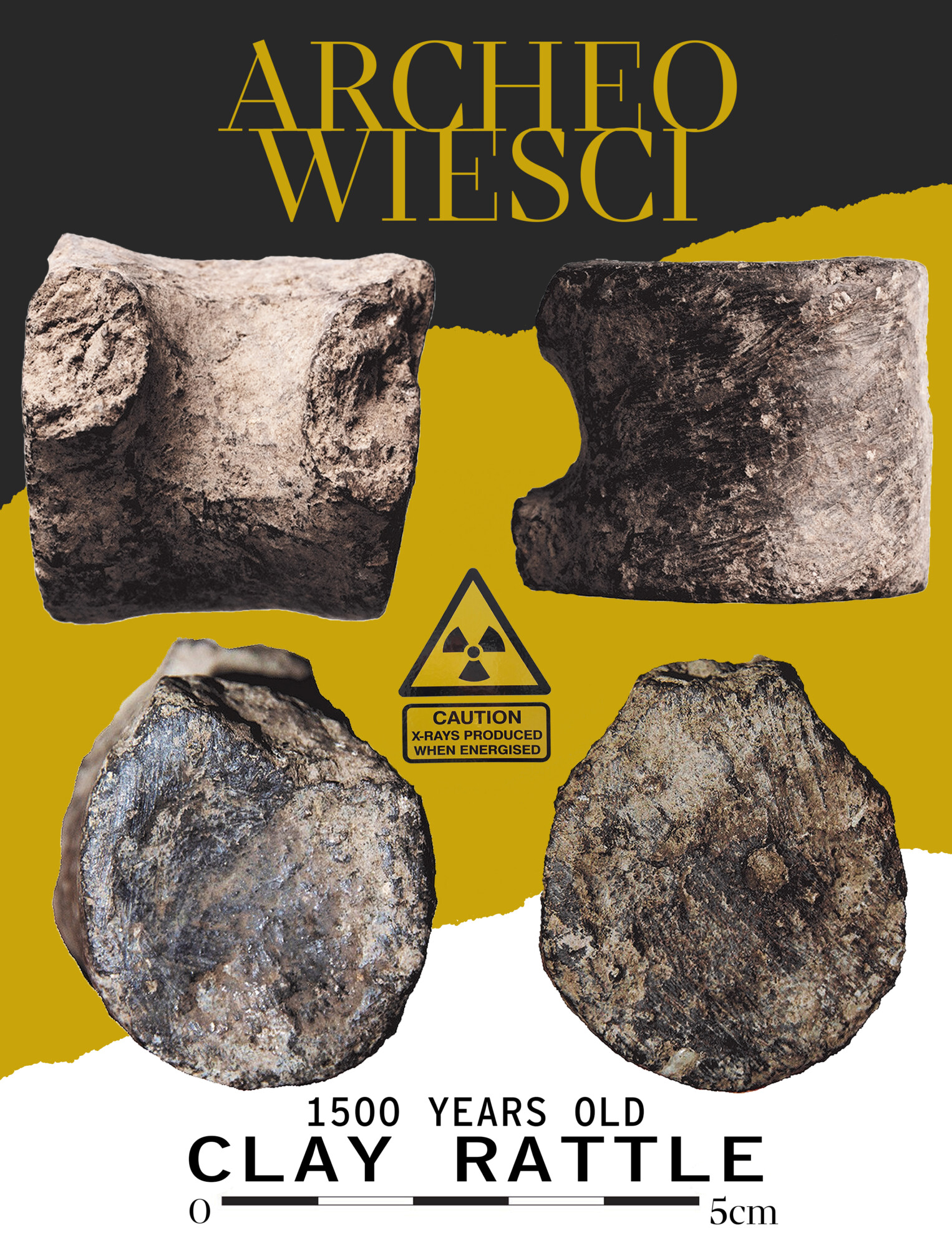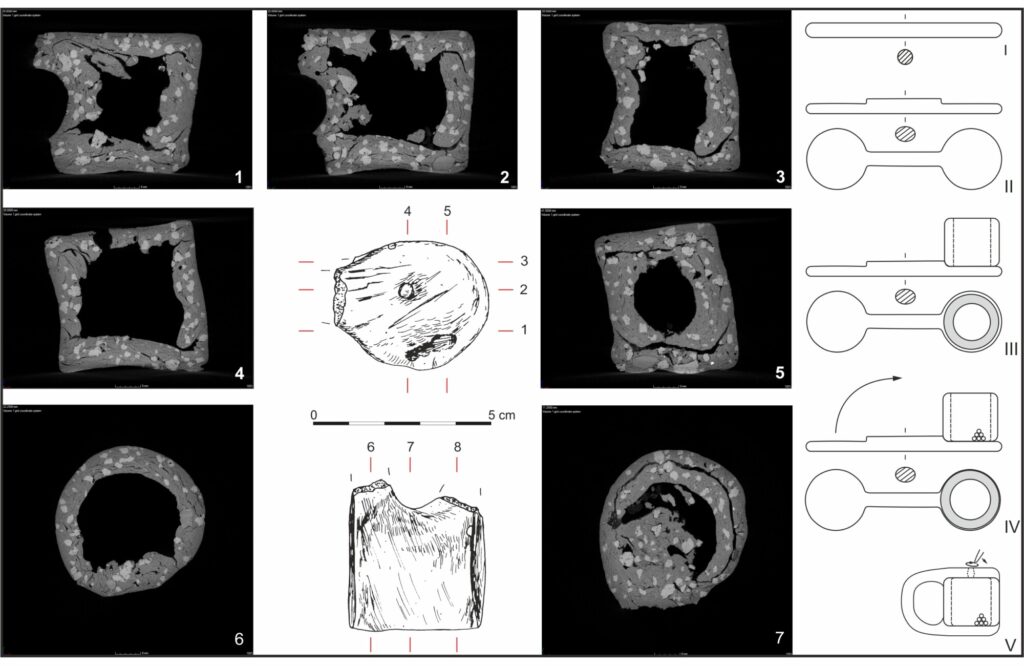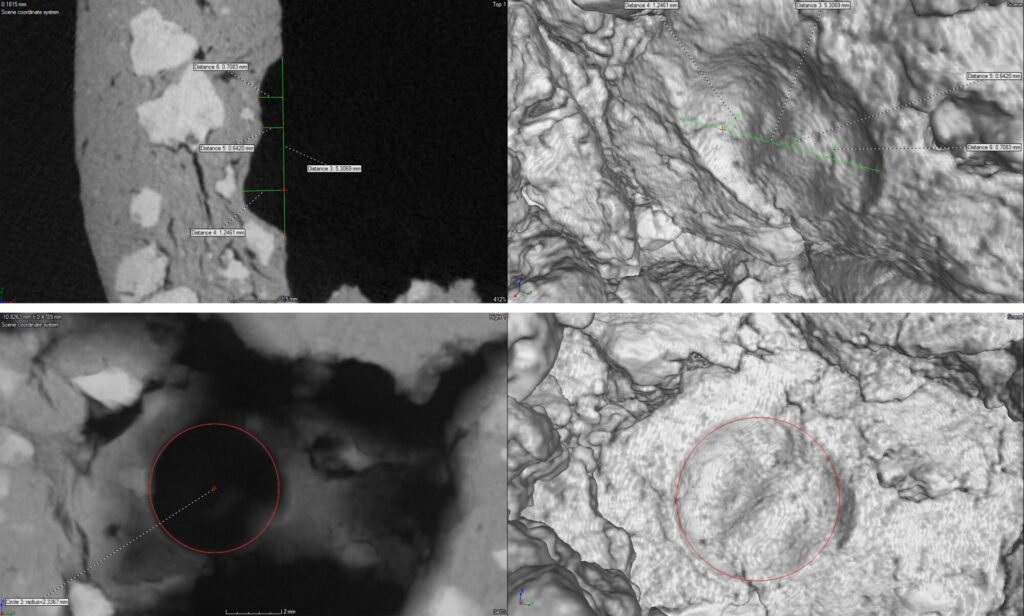
Have you ever held a 1500-year-old clay rattle in your hand? It makes a soft sound when you shake it. There is something inside and it still rattles, just like it did then – 1500 years ago. Was it lost by a careless child playing near the cave? Did it play a role in some forgotten rituals? Or perhaps it was deposited as an offering in a grave? This story will be about a clay rattle.
But let us look at the very beginning. This is 2017 and we launch our research in Koziarnia Cave. The cave sediment has suffered severe damage, which I wrote about earlier. For this reason, we analyse old plans of trenches and identify places that have not been excavated before. The cave was excavated by Ferdinand von Roemer, or by someone he hired, in the 19th century (sparse artefacts that he recovered survived in the Archaeological Museum in Wrocław). Later on, Professor Chmielewski conducted comprehensive research there in the mid-20th century. This means the cave was examined only twice. Everything seems clear.
The history of the research, the story of the rattle…
One day I came across the biography of Stefan Krukowski, one of the founding fathers of Polish archaeology of the Stone Age. He was an outstanding eccentric and a genius of an archaeologist. The biography was written a few years earlier as a result of efforts of another eminent Polish archaeologist, Stefan Karol Kozłowski, who laboured through the archives of the State Archaeological Museum (SAM) in Warsaw to pen it. One of its pages presents a re-print of a field drawing – a section on a millimetre paper and caption: “Koziarnia Cave. Transverse section 4.5 m from the threshold”. I can’t believe it. I search through the digital archive of SAM and eventually find it: a scan of yellowed page of a millimetre paper and the same drawing. There are also some other images. All of them represent sections or cave maps. One of them shows Złodziejska Cave (I will devote a separate text to this site).

© M. Bogacki, CC BY-NC-SA 4.0 licence
I look through the maps and diaries compiled by Professor Chmielewski in the 1960s. Indeed, he found marks of a transverse trench at the entrance to the cave. He noted down in his diary: “marks of a trench, most likely left by von Roemer’s excavations”. How come nobody knew of the research by Krukowski? When Chmielewski launched his excavations, Krukowski was still alive and worked at the Museum in Warsaw. They knew each other and definitely must have met more than once. However, Krukowski never told anybody that he had excavated Koziarnia. He never published his findings. Did I mention he was an eccentric?
Consequently, Chmielewski did not know that he dug into Krukowski’s trench, made 40 years earlier. “Well, if there was exploration, there must also be artefacts”, I think. I call the Museum and ask. They have a box labelled “Sąspów”. I go there together with Dr Marcin Szeliga of the University of Marie Curie-Skłodowska in Lublin, who is responsible for analysis of Neolithic artefacts in our project. We open the box. There are just a few artefacts, but what kind of artefacts! Bone spoon with a label made Krukowski, saying “Łokietek Cave”. So he dug there as well. Apart from this label, there are no mentions of it in the documentation. There are a few flint pieces labelled “Sadlana Cave”. We managed to identify this cave later, thanks to the help of Professor Michał Gradziński of the Jagiellonian University, as Tunel Stromy Cave. We find marks of Krukowski’s trench at its entrance.
The clay rattle – phenomenological approach
Finally, there is a small box labelled “Koziarnia Cave”. Just a few flint pieces and a clay item. I grab the regular cylinder, which is carefully polished. I shake it softly. A rattle! I turn it around, considering its age. We find rattles mostly at sites dating to the Late Bronze Age and Early Iron Age associated with the Lusatian culture. But they are never cylinders, and never with a handle. They usually represent birds or other animals and normally bear beautiful ornamentation. It is difficult to date such a rattle if we have no idea of its context. We usually find either complete rattles – nobody would break them to extract something from inside – or fragments of broken rattles. How are they dated then? In most cases, by the context in which they are found. If they are deposited in a layer with other artefacts from a given period, their chronology is established on the basis of the associated artefacts.
I clean the clay surface of remnants of the sediment with a toothpick: I am looking for ornaments. The dark soil indicates that Krukowski unearthed this artefact in a layer of the so-called Holocene humus, which corresponds with the estimated chronology of the object, but actually tells us very little. Suddenly, a little lump of soil breaks off the top part, it initially blocked a small hole. I turn the rattle upside down. A black round grain drops out of the hole. There are more of them inside. At that moment we realize that we stand a chance of directly establishing the chronology of a clay rattle for the first time!

Drawing: M. Szeliga, Photo: T. Kosiński, CC BY-NC-SA 4.0 licence
And finally: specialist analyses…
The seed is perfect for radiocarbon dating. The Museum gives us a permission for that and we borrow the artefact for non-invasive analyses. Before we send the seed for dating, we show it to researchers from the Institute of Botany of the Polish Academy of Sciences in Cracow. “Pea”, they respond a few days later. The sample is sent for dating and we start other analyses. But what shall we do? How to look inside the rattle without breaking it? We cannot see anything through this small hole. Finally, we decide to try computed tomography. Colleagues from the National Centre for Nuclear Research in Świerk give us a hand. The tomograph scans the rattle: it cuts the artefacts into virtual sections that are a tenth of the millimetre thick. We can examine any section along any axis. In the end, we get a 3D model, both of the inside and of the whole rattle. The sections perfectly show all details.
The inside of the rattle has an irregular surface and roughly the shape of a cylinder. Inside there are some more pea seeds. We notice a round impression of a characteristic shape on one of the walls. One of the pea seeds was impressed in the wall during the making of the object. A palaeobotanist confirms our speculations. Next, as a result of the measurement of this impression, we will be able to reconstruct the initial size of the seeds, but no cylindrical ones. And never with a handle. And they are always extremely rare. Why was this artefact in Koziarnia Cave?

© T. Kosiński, CC BY-NC-SA 4.0 licence
Professor Chmielewski discovered a lot of human remains in the area of the entrance to the cave. They were strongly dispersed. It is difficult to conclude whether they are human burials damaged during the construction of the dance floor at the entrance of the cave. Perhaps they are relics of some rituals during which isolated bones were scattered in this part of the cave? We manage to establish the chronology of the bones. They were all deposited at the same time as the rattle. Everything falls into place. We can hardly avoid the association of the rattle with the human remains, particularly in the light of the fact that some of the identified individuals were children. Could the rattle be an offering placed in the grave of one of the children? Or perhaps, if we accept the theory that the remains are not relics of burials, but rather remains of unidentified rituals, the rattle might have been an element of these rituals? These are the questions that will remain unanswered until someone finds a similar rattle in another context – either funerary or a ritual one.
You can read about the rattle and analyses in an article published in Archäologisches Korrespondenzblatt, entitled “Unique Clay Rattle from Koziarnia Cave in Southern Poland”, authored by Bartosz Kontny, Marcin Szeliga, Michał Wojenka, Tymoteusz Kosiński, Aldona Mueller-Bieniek and Małgorzata Kot.
This article can be re-printed with photographs free of charge provided that the source is cited
Author: Małgorzata Kot
This text was funded by IDUB and the project entitled “From caves to public: A series of popular science articles published on the archeowieści.pl blog, showing a multidisciplinary approach in archaeology, based on the results of our researches in the Ojców Jura” from Inicjatywa Doskonałości – Uczelnia Badawcza programme. Research on the caves of the Sąspowska Valley was funded by the National Science Centre, project: SONATA BIS 2016/22/E/HS3/00486.
References:
Kontny B., Szeliga M., Wojenka M., Kosiński T., Mueller-Bieniek A., Kot M. (2021) Unique Clay Rattle from Koziarnia Cave in Southern Poland, „Archäologisches Korrespondenzblatt” 51(1), 91-209
Kozłowski S.K. (2007) Stefan Krukowski. Narodziny giganta, Warszawa: Państwowe Muzeum Archeologiczne w Warszawie, Stowarzyszenie Naukowe Archeologów Polskich Oddział w Warszawie, ISBN 83-60099-90-1
Project website: https://www.dolinasaspowska.uw.edu.pl
